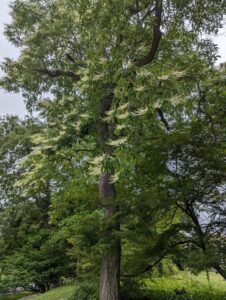 The spine of my home state of New Jersey is the Garden State Parkway, a toll road that stretches for 173 miles, up and down the length of the state. This past week, I drove south on the Parkway, heading for a conference in Atlantic City. While I couldn’t ignore the “Jersey maniacs” weaving in and out of traffic at 90 miles per hour, or the intermittent bottlenecks caused by road construction, I was struck by the beauty of the fall foliage. Weather and atmospheric conditions have made the show especially spectacular this year, with great balls of red-orange competing with cascades of yellow and billows of russet leaves. Even the Pine Barrens, home to innumerable evergreens, was illuminated by the color of deciduous trees taking their last bow before winter.
The spine of my home state of New Jersey is the Garden State Parkway, a toll road that stretches for 173 miles, up and down the length of the state. This past week, I drove south on the Parkway, heading for a conference in Atlantic City. While I couldn’t ignore the “Jersey maniacs” weaving in and out of traffic at 90 miles per hour, or the intermittent bottlenecks caused by road construction, I was struck by the beauty of the fall foliage. Weather and atmospheric conditions have made the show especially spectacular this year, with great balls of red-orange competing with cascades of yellow and billows of russet leaves. Even the Pine Barrens, home to innumerable evergreens, was illuminated by the color of deciduous trees taking their last bow before winter.
The autumn show is all about chlorophyll, that chemical substance that makes the leaves green during the growing season. As days shorten and temperatures cool, chlorophyll production slows, allowing the fall colors to emerge. They don’t last long, and leaf drop may be hastened by high wind or rainstorms. In New Jersey this year, we are in a period of prolonged drought, which is a double-edged sword when it comes to trees and plant life. The gorgeous autumn leaves stay on the trees longer, but the danger that they will be swept away by wildfires increases exponentially.
Numerous online lists categorize the best trees for fall color, and the lists are lengthy enough so that those looking for showy trees can find the right ones for just about any geographical or climate situation. We all know about the maples—especially the red and sugar maple varieties—that glow with fire in late September and early October. When I see a fall maple, I always think of the little mouse ear-sized leaves that emerged last spring, without even the slightest hint of the glory to come. Many of their Japanese maple cousins, which are smaller and more manageable on average-size lots, are also magnificent with their red, orange, yellow or bronze-purple “fingery” leaves.
In my own neighborhood, the gingko trees are sporting brilliant golden fans that wave in the October light. They are very susceptible to leaf drop when hard freezes come early. This year they are persisting beautifully. Gingkos have been characterized as “living fossils”, because of their long history on earth. At this moment, in this place, they have never been more alive.
Some people hate sweet gum trees because of the spiky fruit capsules that they produce in enormous numbers. The “gum balls” are hard on tender feet and messy to clean up. Still, tree guru Professor Michael Dirr says that the best sweet gum trees are so glorious in the fall that they might be grown solely for the beauty of their star-shaped leaves.
When my daughter was young, she was fascinated by the North American native sassafras trees—mostly self-sown—that we would see in untended spaces near home, as well as out in the country. The leaves are variable, sometimes looking like right or left-handed mittens, with two unequal lobes, and sometimes resembling tridents, with three equal lobes. In the fall, all those mittens and tridents turn brilliant shades of red, yellow, orange and purple. It is really a pity that more people don’t grow sassafras on purpose. They are tough, hardy and interesting in all seasons.
In smaller landscapes, the paperbark maple is a fall champion. The exfoliating bark continues to peel as the seasons progress, and the summer foliage is lovely, with dark green leaves that reveal blue-green undersides when the wind blows. Those same leaves flame red and orange in fall.
One of the prominent street corners in my neighborhood is home to a mature sourwood or Oxydendrum arboreum. Sometimes known as the “lily-of-the-valley tree”, the sourwood produces cascading racemes of bell-shaped white flowers in the spring, in a configuration that is unmistakeable. By fall, those fragrant flowers are a thing of the past, but the leaves turn yellow, red and purple—truly showy. Sourwood is another native plant that should be used more. It generally grows 25 to 30 feet tall and spreads about 20 feet.
People complain perpetually about leaf raking—even those people whose leaves are dispatched by landscaping crews. I think it is a small price to pay for the beauty that Nature reveals as this part of the globe moves towards winter.
